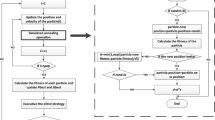Abstract
This paper proposes an improved local search metaheuristic using simulated annealing method with memory component (MSA) for solving the unit commitment problem (UCP) with ramp constraints. The proposed method benefits simultaneously from the advantages of a two metaheuristics: acceptance of “bad” solutions in order to escape from local optimal configurations (SA), and prohibition for a time period of certain areas already been searched (Tabu list) as used in Tabu search method. The proposed effective MSA method is tested on several systems as the conventional ten unit test system and its multiples with 24-h scheduling horizon and the IEEE 118-bus system with 54 units. To justify the success of the MSA method, a comparison of results with those of other metaheuristic methods and hybrid methods treated by recent references is made. The results show that the proposed method obtains less total operation costs than the others with an acceptable time computing and indicate its potential for solving the UCP.

Similar content being viewed by others
Abbreviations
- MSA:
-
Memory simulated annealing
- TS:
-
Tabu search
- GRASP:
-
Greedy randomized adaptive search procedure
- EP:
-
Evolutionary programming
- GA:
-
Genetic algorithm
- GAUC:
-
Genetic algorithm based on unit characteristic classification
- IPSO:
-
Improved particle swarm optimization
- MA:
-
Memetic algorithm
- BCGA:
-
Binary coded genetic algorithm
- ICGA:
-
Integer coded genetic algorithm
- LRGA:
-
Lagrangian relaxation-genetic algorithm
- SFA:
-
Straightforward algorithm
- F T :
-
Total operation cost ($)
- P i (t):
-
Generation output of unit i at hour t (MW)
- N :
-
Set of indexes of the generating units
- I :
-
Index of units
- N t :
-
Set of indexes of the time periods (h)
- t :
-
Index of time periods
- U i (t):
-
Status of unit i at hour t (on = 1, off = 0)
- a i , b i , c i :
-
Coefficients of quadratic fuel cost function of unit i
- S i (t):
-
Start up cost of unit i at hour t ($)
- P D (t):
-
System load demand at hour t (MW)
- \({P_i^{\max}}\) :
-
Maximum output power of unit i (MW)
- \({P_i^{\min}}\) :
-
Minimum output power of unit i (MW)
- P R(t):
-
System spinning reserve at hour t (MW)
- ST i (t):
-
Start-up cost of unit i ($)
- CSC i :
-
Cold start up cost of unit i ($)
- HSC i :
-
Hot start up cost of unit i ($)
- SC i :
-
Cold start up time of unit i (h)
- DC i (t):
-
Shut-down cost of unit i ($)
- \({X_i^{\rm ON}}\) :
-
Continuous on time of unit i (h)
- \({X_i^{\rm OFF}}\) :
-
Continuous off time of unit i (h)
- UR i :
-
Ramp-up rate limit of unit i (MW/h)
- DR i :
-
Ramp-down rate limit of unit i (MW/h)
- MDT i :
-
Minimum down time of unit i (h)
- MUT i :
-
Minimum up time of unit i (h)
- T 0,T min :
-
Initial and minimal temperature
- α :
-
Temperature reduction factor
- TL:
-
Tabu list
- itrmax :
-
Maximum number of iterations
- PL:
-
Priority list of units
- P load :
-
Priority list of loads
References
Wood A.J., Wollenberg B.F.: Power Generation, Operation and Control. 2nd edn. Wiley, New York (1996)
Bard J.F.: Short-term scheduling of thermal-electric generators using Lagrangian relaxation. Oper. Res. 36(5), 756–766 (1988)
Mohammedi, R.D.: Etude du problème d’Engagement de Turbines (Unit Commitment) par la Programmation Dynamique et autres Techniques Avancées. In: Mémoire de Magister, Université Ammar Télidji de Laghouat, Algérie, Juin (2008)
Kazarlis S.A., Bakirtzis A.G., Petridis V.: A genetic algorithm solution to the unit commitment problem. IEEE Trans. Power Syst. 11(1), 83–92 (1996)
Simon P.S., Padhy N., Anand R.S.: An ant colony system approach for unit commitment problem. Electr. Power Syst. Res. 28(5), 315–323 (2006)
Purushothama G.K., Jenkins L.: Simulated annealing with local search-a hybrid algorithm for unit commitment. IEEE Trans. Power Syst. 18(1), 273–278 (2003)
Viana A., Pinho J., Matos M.: Using GRASP to solve the unit commitment problem. Ann. Oper. Res. 120(1), 117–132 (2003)
Juste K.A., Kita H., Tanaka E., Hasegawa J.: An evolutionary programming solution to the unit commitment problem. IEEE Trans. Power Syst. 14(4), 1452–1459 (1999)
Zhao B., Guo C.X., Bai B.R., Cao Y.J.: An improved particle swarm optimization algorithm for unit commitment. Electr. Power Energy Syst. 28(7), 482–490 (2006)
Senjyu T., Yamashiro H., Uezato K., Funabashi T.: A unit commitment problem by using genetic algorithm based on unit characteristic classification. IEEE Power Eng. Soc. Winter Meet. 1, 58–63 (2002)
Valenzuela J., Smith A.: A seeded memetic algorithm for large unit commitment problems. J. Heuristics 8(2), 173–195 (2002)
Damousis I.G., Bakirtzis A.G., Dokopoulos P.S.: A solution to the unit commitment problem using integer-coded genetic algorithm. IEEE Trans. Power Syst. 19(2), 1165–1172 (2004)
Cheng C.P., Liu C.W., Liu C.C.: Unit commitment by Lagrangian relaxation and genetic algorithms. IEEE Trans. Power Syst. 15(2), 707–714 (2000)
Dang C., Li M.: A floating-point genetic algorithm for solving the unit commitment problem. Eur. J. Oper. Res. 181(3), 1370–1395 (2007)
Sun L., Zhang Y., Jiang C.: A matrix real-coded genetic algorithm to the unit commitment problem. Electr. Power Syst. Res. 76(9), 716–728 (2006)
Hosseini S.H., Khodaei A., Aminifar F.: A novel straightforward unit commitment method for large-scale power systems. IEEE Trans. Power Syst. 22(4), 2134–2143 (2007)
The data of IEEE 118-bus system consisting of 54 units. http://ee.sharif.edu/IEEE_118_BUS.doc
Author information
Authors and Affiliations
Corresponding author
Rights and permissions
About this article
Cite this article
Arif, S., Mohammedi, R.D., Hellal, A. et al. A Memory Simulated Annealing Method to the Unit Commitment Problem with Ramp Constraints. Arab J Sci Eng 37, 1021–1031 (2012). https://doi.org/10.1007/s13369-012-0217-2
Received:
Accepted:
Published:
Issue Date:
DOI: https://doi.org/10.1007/s13369-012-0217-2




